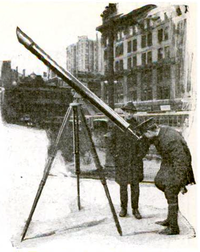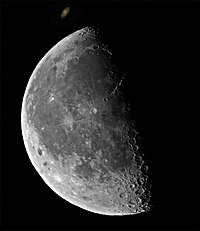Sidewalk astronomy
 From Wikipedia - Reading time: 6 min
From Wikipedia - Reading time: 6 min

Sidewalk astronomy[1] or street corner astronomy[2][3] refers to the activity of setting up a telescope in an urban place on a for-profit or non-profit basis as entertainment and/or for public education.
Overview
[edit]Examples of people setting up telescopes on urban streets for public astronomical viewing go back well into the 19th century and maybe even further.[4][5][6][7] Sidewalk astronomers and their telescopes have been a common sight in most big cities.[8] There are many examples in the past such as Frank Manning in New Orleans as early as 1930[9] and Mr Grosser in Los Angeles in the 1870s, who not only set up a telescope but also an illuminated microscope. Some sidewalk "pitch men" charged the public to view astronomical objects through their telescope but other astronomers allow people to view for free.[6][10] In more recent years sidewalk astronomy has come to be more associated with altruistic individuals or groups offering views of the nighttime sky as a free public educational service.[11]
Because the sidewalks tend to be in light-polluted areas, sidewalk astronomers often coordinate their activities at times when brighter celestial objects like planets, the Moon, and bright stars are visible. During the day, sidewalk astronomy often includes use of a solar filter on the telescope to allow people to view the Sun. Telescopes are often larger than the average available "department store telescope", sometimes very large.[2][11]
Amateur astronomical activities
[edit]
With the advent and growth of organized amateur astronomical groups, sidewalk astronomy has come to be associated with public education about astronomy via free public viewing for anyone who wishes to look through the telescope. This usually involves individual or a groups of amateur astronomers with small-to-medium-sized telescopes. Organizations such as the San Francisco Sidewalk Astronomers, founded by John Dobson, are organized around the idea of educating people about the universe they live in by having them look through telescopes.[12][13][14][15] Dobson even promoted a design for large inexpensive reflecting telescope that he called a "Sidewalk Telescope", more commonly referred to as the Dobsonian telescope.[16]
See also
[edit]- Amateur astronomy
- Citizen science
- Star party
- A Sidewalk Astronomer, 2005 documentary about John Dobson's activities, including sidewalk astronomy
References
[edit]- ^ "Sidewalk astronomy: Taking it to the streets". Article Archives. Jet Propulsion Laboratory, California Institute of Technology. Retrieved 2009-06-24.
- ^ a b Latimer J. Wilson, Adventures in Street Corner Astronomy, Popular Science Mar 1921
- ^ Frederick News Post - What's it like ... to be a street corner astronomer? Originally published October 16, 2008 - Herman Heyn, Bal street corner astronomer. Archived February 29, 2012, at the Wayback Machine
- ^ The Story of the Heavens - By Robert Stawell Ball – Herschel, after 1774
- ^ The Historical Society of Southern California quarterly by the Historical Society of Southern California, Pioneers of Los Angeles County v. 38 – 1956 “The "sidewalk astronomer" was conspicuous in Los Angeles. One such gentleman in the late 1870s and early 1880s was Mr Grosser by name, who, for a small fee would allow the passerby to gaze not only through his sizeable telescope but also through the illumined microscope he carried”
- ^ a b Theatrical management in the West and South for thirty years By Solomon Smith, Sinclair Hamilton Collection of American Illustrated Books before 1868 – mention for pay
- ^ Journal of the Franklin Institute – 1880 – page 418 - Sidewalk Astronomers in Paris
- ^ Jerome Sydney Meyer, "Great inventions" - Page 51
- ^ Brown, John (2009-01-16), John Brown's New Orleans Sidewalk Astronomy web page, archived from the original on 2009-01-26, retrieved 2024-05-31
- ^ Friends' intelligencer Page 298 1862
- ^ a b "Moser, Don (2005-11-01), 35 Who Made a Difference: John Dobson, Smithsonian.com, archived from the original on 2009-03-11, retrieved 2024-05-31
- ^ Sidewalk Astronomers
- ^ Los Angeles Sidewalk Astronomers - The Sidewalk Astronomers, who we are and what we do!
- ^ Liverpool Astronomical Society Sidewalk Astronomers
- ^ John Dobson: Amateur Astronomy's Revolutionary, Space.com, 5 May 2000, p. 2, archived from the original on 2009-05-24, retrieved 2009-06-23
- ^ Watson, Fred (October 2007). Why Is Uranus Upside Down?. Inc. NetLibrary. p. 17. ISBN 9781741762761.
 KSF
KSF